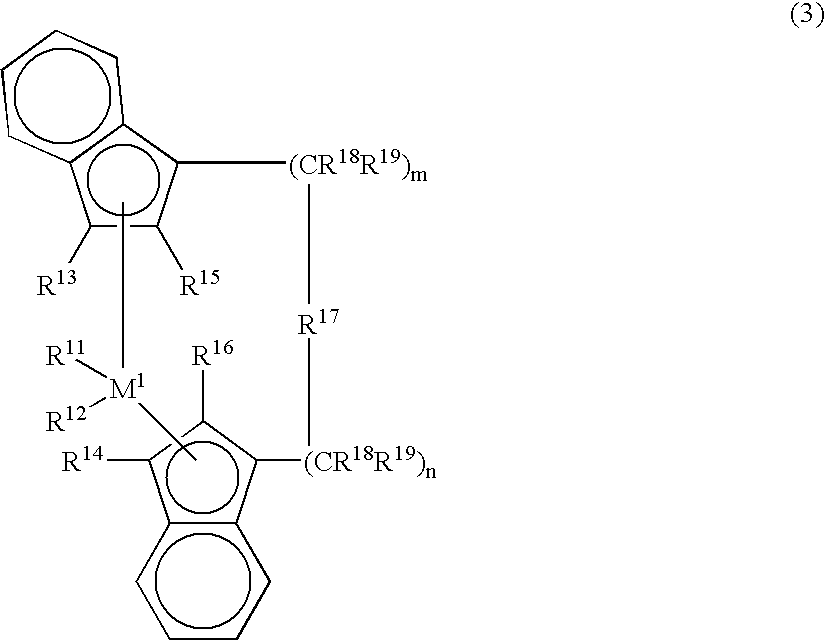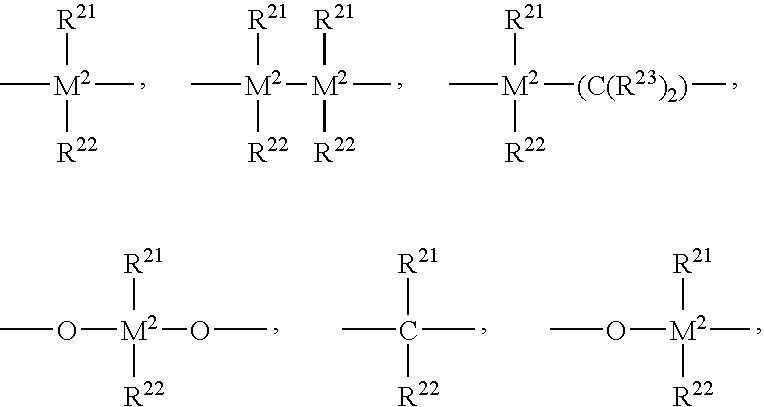Process for producing injection molded product
a technology of injection molding and product, which is applied in the field of thermoplastic resin, can solve the problems of insufficient detail of the mold shape, the molded article adheres to the mold, and the molded article may not be able to achieve the properties of mechanical strength, heat resistance, impact resistance, etc., and achieves the effect of improving releasability, thin molding, and longer flow length of thermoplastic resin
- Summary
- Abstract
- Description
- Claims
- Application Information
AI Technical Summary
Benefits of technology
Problems solved by technology
Method used
Image
Examples
example 1
of Metallocene Compound
[0165] When the metallocene compound represented by the above formula (1) has a transition metal valence of, for example, 4, this metallocene compound is more specifically represented by the following formula (2):
R2kR3lR4mR5nM1 (2)
[0166] wherein M1 is a transition metal selected from Group 4 of the periodic table, R2 is a group (ligand) having cyclopentadienyl skeleton, and R3, R4 and R5 are each independently a group (ligand) having or not having cyclopentadienyl skeleton, k is an integer of 1 or greater, and k+l+m+n=4.
[0167] Examples of the metallocene compounds having zirconium as M1 and having at least two ligands having cyclopentadienyl skeleton include bis(cyclopentadienyl)zirconium monochloride monohydride, bis(cyclopentadienyl)zirconium dichloride, bis(1-methyl-3-butylcyclopentadienyl)zirconium-bis(trifluoromethanesulfonate) and bis(1,3-dimethylcyclopentadienyl)zirconium dichloride.
[0168] Also employable are compounds wherein the 1,3-position subs...
example 2
of Metallocene Compound
[0171] Another example of the metallocene compound is a metallocene compound represented by the following formula (3) that is described in JP-A No. Hei 4-268307.
[0172] In the above formula, M1 is a transition metal of Group 4 of the periodic table, specifically titanium, zirconium or hafnium.
[0173] R11 and R12 may be the same as or different from each other and are each a hydrogen atom, an alkyl group of 1 to 10 carbon atoms, an alkoxy group of 1 to 10 carbon atoms, an aryl group of 6 to 10 carbon atoms, an aryloxy group of 6 to 10 carbon atoms, an alkenyl group of 2 to 10 carbon atoms, an arylalkyl group of 7 to 40 carbon atoms, an alkylaryl group of 7 to 40 carbon atoms, an arylalkenyl group of 8 to 40 carbon atoms or a halogen atom. R11 and R12 are each preferably a chlorine atom.
[0174] R13 and R14 may be the same as or different from each other and are each a hydrogen atom, a halogen atom, an alkyl group of 1 to 10 carbon atoms which may be halogenated...
example 3
of Metallocene Compound
[0177] As the metallocene compound, a metallocene compound represented by the following formula (4) is also employable.
[0178] In the formula (4), M3 is a transition metal atom of Group 4 of the periodic table, specifically titanium, zirconium or hafnium. R24 and R25 may be the same as or different from each other and are each a hydrogen atom, a halogen atom, a hydrocarbon group of 1 to 20 carbon atoms, a halogenated hydrocarbon group of 1 to 20 carbon atoms, a silicon-containing group, an oxygen-containing group, a sulfur-containing group, a nitrogen-containing group or a phosphorus-containing group. R24 is preferably a hydrocarbon group, particularly preferably an alkyl group of 1 to 3 carbon atoms, i.e., methyl, ethyl or propyl. R25 is preferably a hydrogen atom or hydrocarbon group, particularly preferably a hydrogen atom or an alkyl group of 1 to 3 carbon atoms, i.e., methyl, ethyl or propyl. R26, R27, R28 and R29 may be the same as or different from one...
PUM
| Property | Measurement | Unit |
|---|---|---|
| Temperature | aaaaa | aaaaa |
| Temperature | aaaaa | aaaaa |
| Temperature | aaaaa | aaaaa |
Abstract
Description
Claims
Application Information
 Login to View More
Login to View More - R&D
- Intellectual Property
- Life Sciences
- Materials
- Tech Scout
- Unparalleled Data Quality
- Higher Quality Content
- 60% Fewer Hallucinations
Browse by: Latest US Patents, China's latest patents, Technical Efficacy Thesaurus, Application Domain, Technology Topic, Popular Technical Reports.
© 2025 PatSnap. All rights reserved.Legal|Privacy policy|Modern Slavery Act Transparency Statement|Sitemap|About US| Contact US: help@patsnap.com



